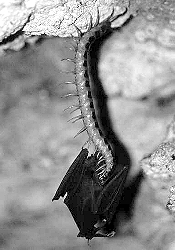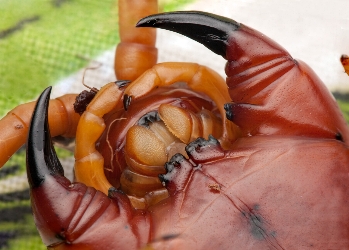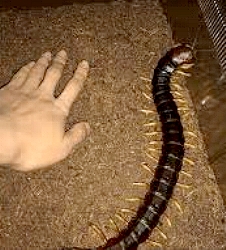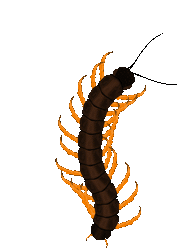 The Scolopendra gigantea, also known as the giant yellow-leg centipede or Amazonian giant centipede, is a species of centipede that packs a painful, venomous bite. The carnivorous arthropod uses its powerful venom to prey on small rodents, as well as large insects and reptiles.  Its long, flattened body has up to 27 segments, with 21 pairs of legs. Its first pair of legs double as claws, which it uses to lunge at prey and inject venom. This huge insect can be found in Colombia and Venezuela in South America, as well as the nearby islands of Aruba, Curaçao, and Trinidad. Some specimens have been found in the U.S. Virgin Islands, Haiti, Mexico and Honduras.
Its long, flattened body has up to 27 segments, with 21 pairs of legs. Its first pair of legs double as claws, which it uses to lunge at prey and inject venom. This huge insect can be found in Colombia and Venezuela in South America, as well as the nearby islands of Aruba, Curaçao, and Trinidad. Some specimens have been found in the U.S. Virgin Islands, Haiti, Mexico and Honduras. A similarly sized and just as deadly centipede, Scolopendra heros, commonly referred to as the giant desert centipede, is the largest centipede in North America. This desert centipede can be found throughout the southern United States and Mexico.  Centipedes usually live under wood, bark and in tropical forest leaf litter. They can sometimes be found sheltering in caves. Most range from 12 to 23 centimetres long, but individuals as big as 28 centimetres have been found. The insect is big enough to prey upon small mammals and lizards. They will take advantage of whatever appropriately sized meal they come across, which can sometimes include other centipedes.
Centipedes usually live under wood, bark and in tropical forest leaf litter. They can sometimes be found sheltering in caves. Most range from 12 to 23 centimetres long, but individuals as big as 28 centimetres have been found. The insect is big enough to prey upon small mammals and lizards. They will take advantage of whatever appropriately sized meal they come across, which can sometimes include other centipedes.Scolopendra gigantea living in limestone caves in Venezuela will crawl up the walls of the caves, hang upside down, and catch, kill and feed on at least three species of bats that live in the cave. The bats are heavier than the centipedes. Giant Scolopendra kept in captivity are sometimes fed small mice. The centipede is able to kill large prey by immobilizing it with their venom. The venom gland is located in a modified leg pair that lies under the head. The neurotoxic venom, containing chemicals that disrupt the nervous system of humans or animals, is injected by the fang of this leg pair and it kills the prey. 
  There is no question that a bite would be painful to humans. Centipede bites are very rarely fatal to humans, but the pain can be intense and local swelling is common. There has only ever been one confirmed death from a centipede bite. There is no question that a bite would be painful to humans. Centipede bites are very rarely fatal to humans, but the pain can be intense and local swelling is common. There has only ever been one confirmed death from a centipede bite. In 2014, a child in Venezuela was bitten by a centipede that had been lurking in a soda can. The child was rushed to the hospital but their condition rapidly worsened and they died. Researchers at the Universidad de Oriente later confirmed that the species had been Scolopendra gigantea.   Watch a fascinating video about centipedes hunting, including killing prey that includes mice and small birds. [not for the squeamish] |